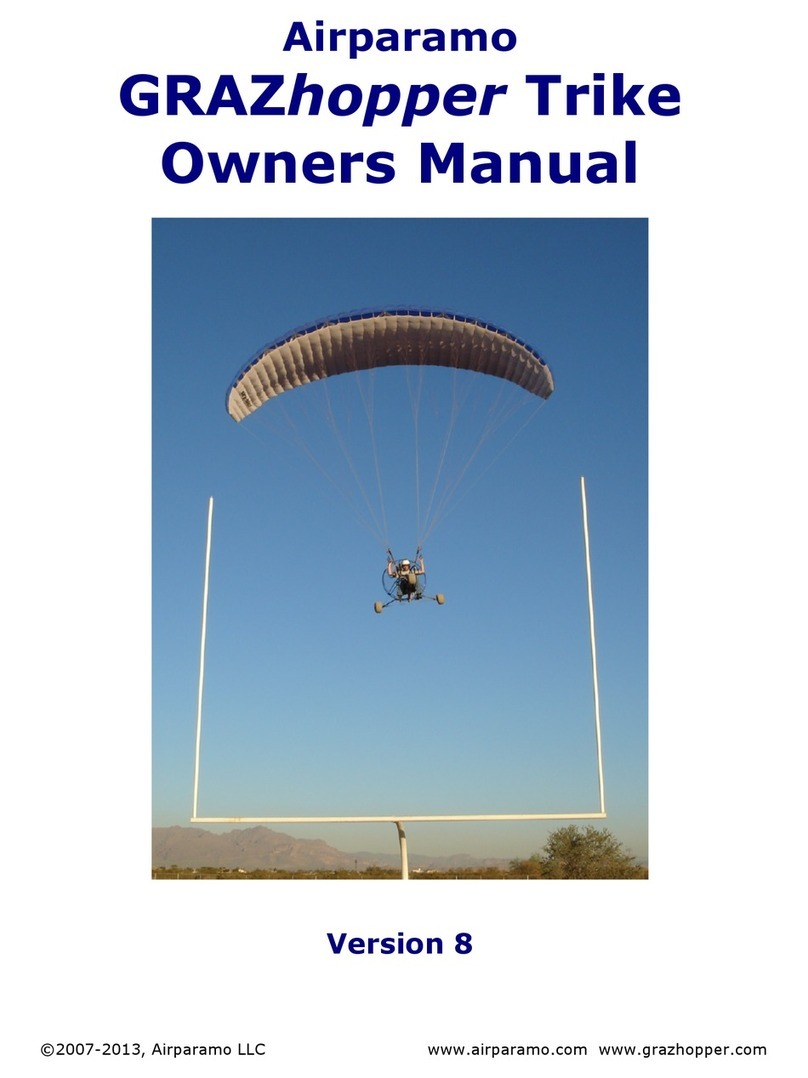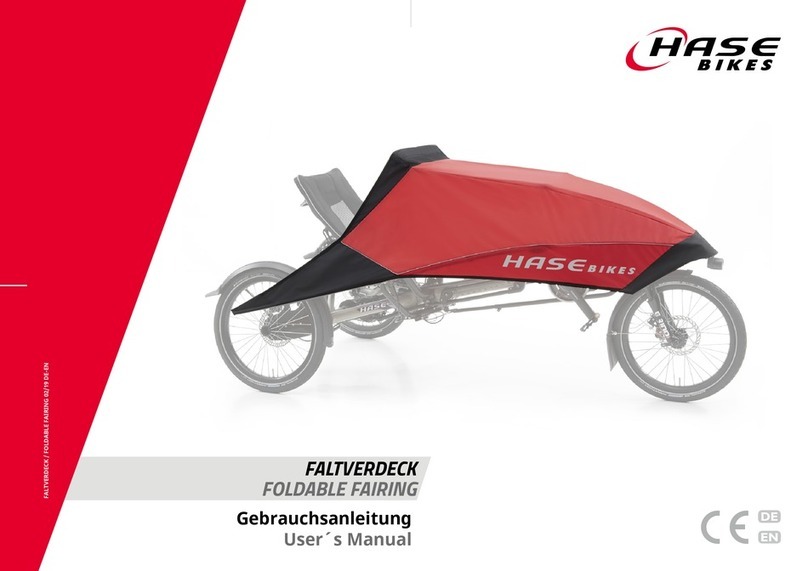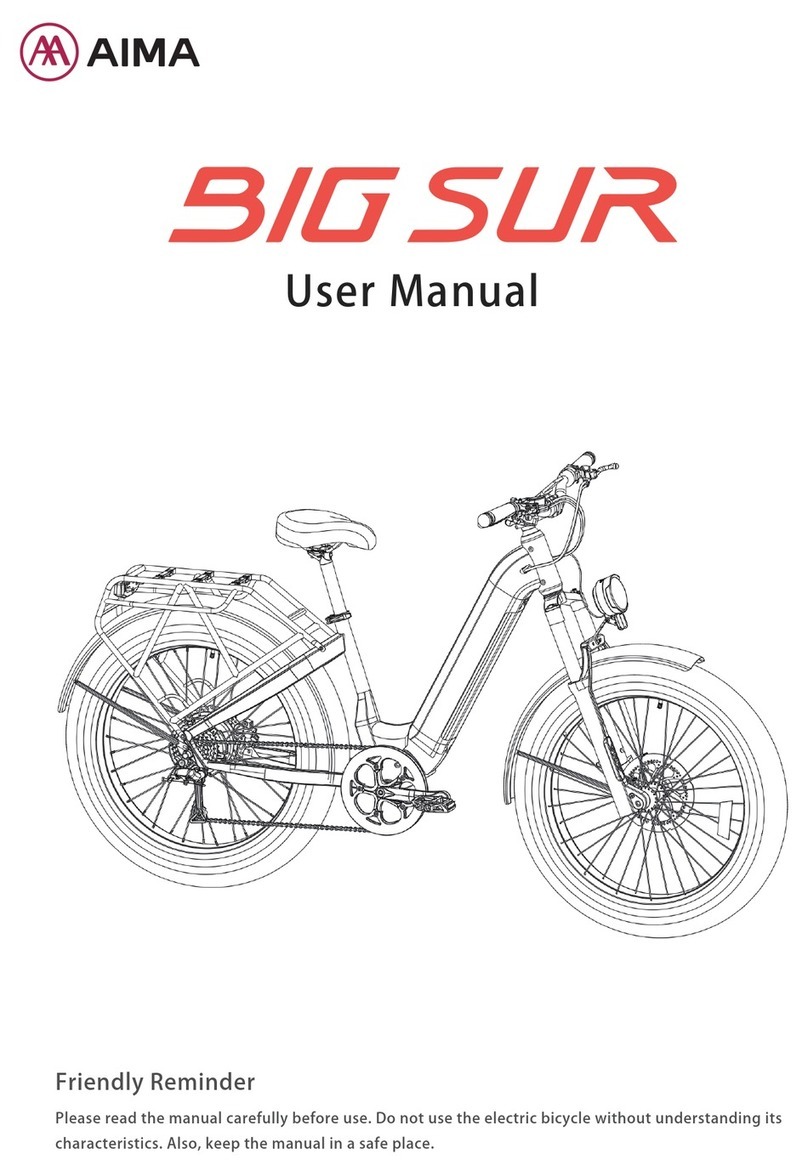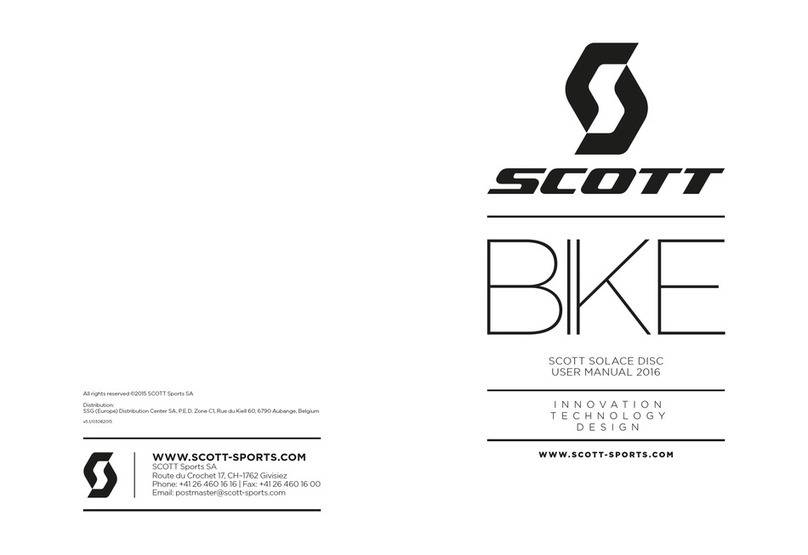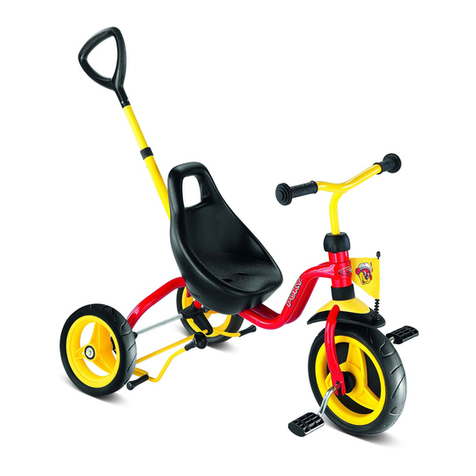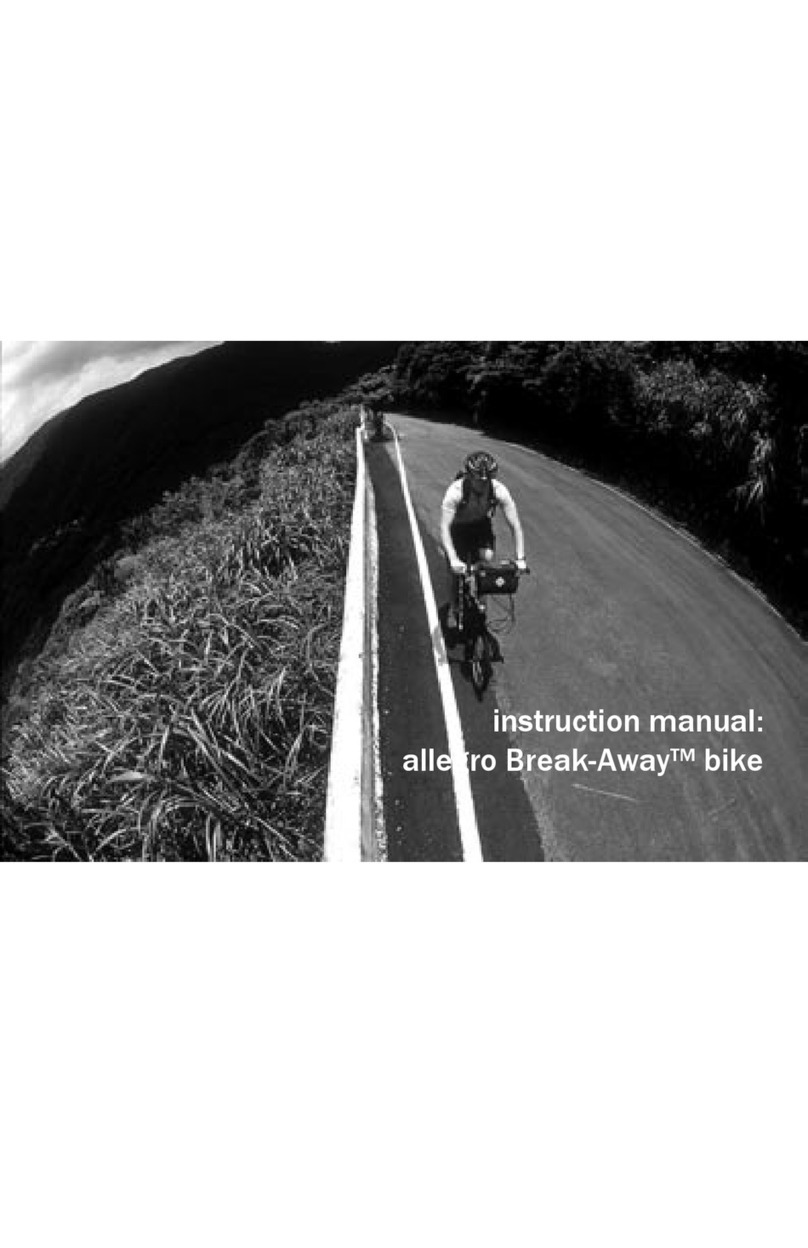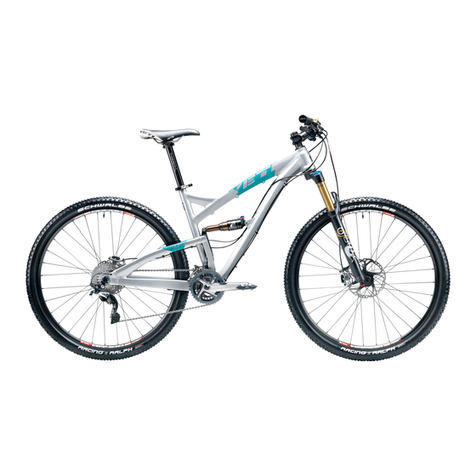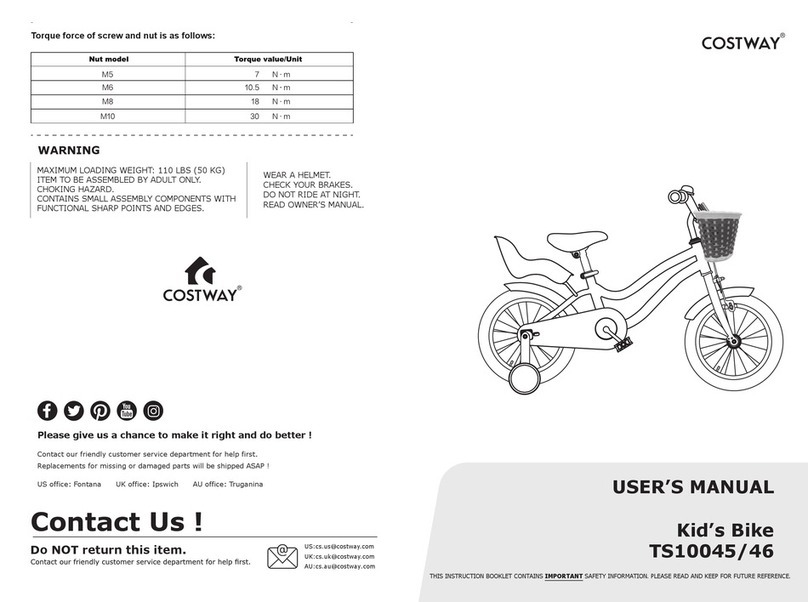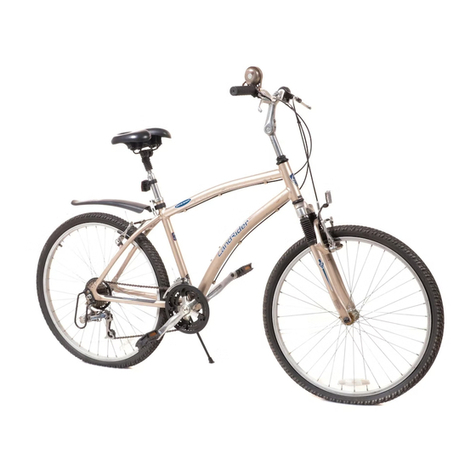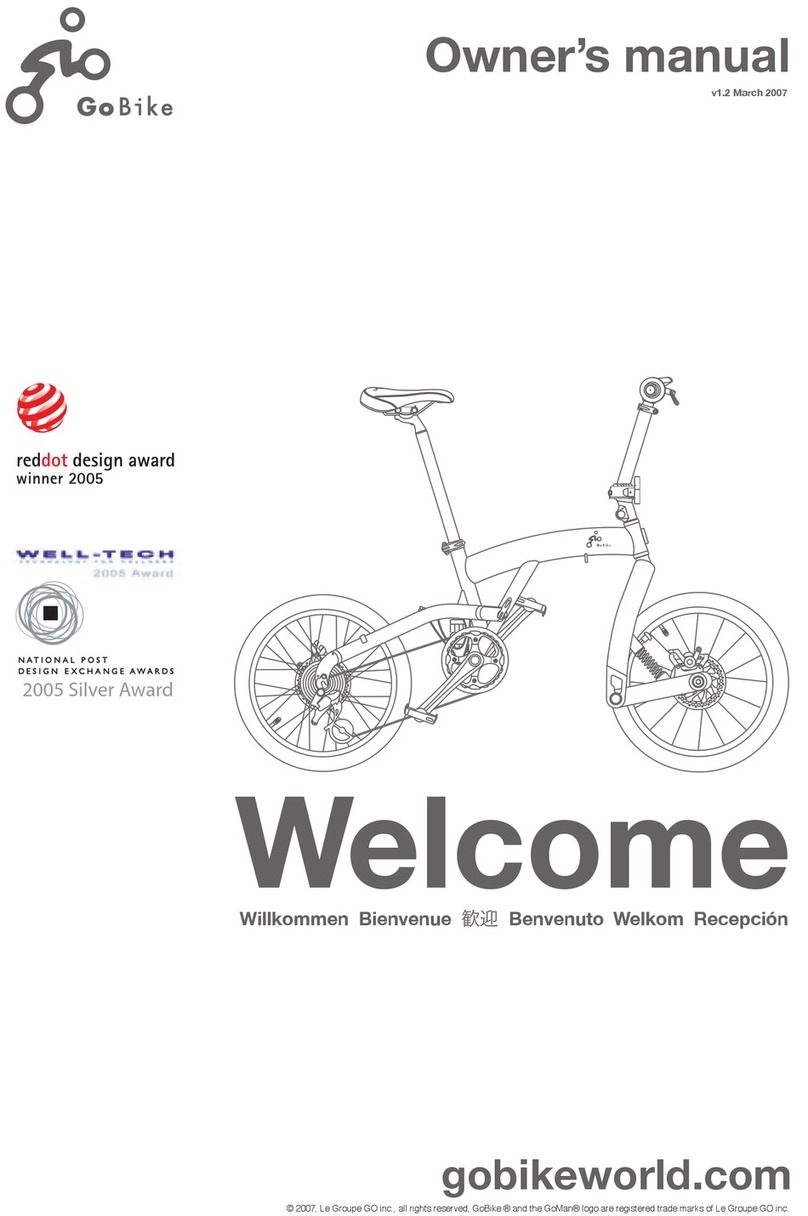Edbikes 26" City Bike User manual

Ed
EdEd
Edbike
bikebike
bikes
ss
s
Owner’s Manual
26” City Bike
We strongly recommend that you read this entire manual before using your electric bike
Nov-2017

2
Contents
1 Introduction 3
2 Caring for your Edbike bike and pre-use checks 4
2.1 Before you set off for the first time
2.2 Before each use
2.3 Battery care
2.4 Recharging your battery
2.5 Water
2. Maintenance and adjustments
2.7 Technical specifications & performance
2.8 Simple Trouble shooting
3 Controls and equipment 9
3.1 Battery on/off switch and lock
3.2 The ON/OFF button and Light button
3.3 The Throttle
3.4 Battery capacity meter, riding style and affect on range
3.5 Brakes
3. Stem and handle bar clamps
3.7 Folding mechanisms
3.8 The connectors
3.9 Quick release saddle height adjustment
3.10 Rims and spokes
3.11 Chain and drive wheel removal
3.12 Derailleur and gear change
4 Warranty, battery maintenance and user responsibilities 134
4.1 Battery maintenance and user responsibilities
5 Service 15

3
1Introduction
Thank you for choosing an Edbike electric bicycle.
Before you use your Edbike electric bike it is important that you read this manual carefully. If there is
anything you do not understand completely, please contact us.
Please observe traffic regulations, and do not lend your bicycle to anyone who is unfamiliar with it.
We recommend your electric bike only be used by a person aged fourteen years or older, always
supervise children until they are competent riders.
We strongly advise you to always wear an approved cycle helmet when riding your bicycle. If you are
unfamiliar with cycling, we advise attending a cycle proficiency course prior to using your new
bicycle on the public highway.
When using any bicycle, it is important that you stay within safe limits; if you feel as if you are
travelling too quickly, you probably are.
Always test your brakes prior to using the bike, and remember the bike will not stop as quickly in the
wet as it would in the dry!
Always be careful of using the front brake when turning or on slippery surfaces as locking of the
front wheel can be dangerous and result in falling off.
Before you use the bike for the first time, please make absolutely certain that it has been correctly
assembled. In particular, you must make sure that the pedals, saddle, handle bars and any self
assembled items have been fitted correctly and tightened.
Avoid consuming alcohol before you ride your electric bike. The use of alcohol greatly reduces
reflexes and limits your ability to ride safely. The legal limit and penalties for operating a motor
vehicle apply to cyclists.
If you need to replace your battery, please dispose of it properly.
Above all, enjoy your Edbike bike, happy cycling!

2Caring for your Edbike bike and pre-use checks
Your Edbike bike has been thoroughly tested at the factory prior to delivery, and undergone a pre-
delivery inspection by your Edbike Stockist.
It is very important that you check the bike thoroughly before its first use. Equally important are
frequent and regular spot-checks, as they will protect you and your Edbike bike.
Please read this manual carefully.
2.1 Before you set off for the first time
2.1.1 Check the handlebars and handlebar stem are properly tightened.
2.1.2 Check all other nuts, bolts and fixings are properly tightened.
2.1.3 Check brakes are functioning properly.
2.1.4 Check tyre pressures are correct and tyres are not damaged.
2.1.5 Check reflectors and lights if fitted, are functioning properly.
2.1. Make sure the battery is fully charged.
2.1.7 Load the battery into bicycle and turn on with the switch . To remove the battery, turn the
battery key anticlockwise to “off” then press inwards and continue to turn until the battery
slides out.
2.1.8 Turn on the bike by pressing the on/off switch adjacent to the left hand grip for two
seconds. (Turn off the bike by repeating the same process).
Fig 1
The bike will be ready to ride and the LCD will activate showing battery state, assist level,
time, trip and speed. Turning the pedals for more than ¼ of a revolution or twisting the
throttle (if fitted) will now activate the motor.

5
2.1.9 To avoid unplanned acceleration, always make sure that the LCD assist level is set to 0 when
mounting, dismounting and turn the bike off when leaving it unattended.
To set the assist levels, toggle with the up and down arrow buttons. (see fig 1)
2.1.10 To reset trip meter double tap the POWER button.
Battery care
2.3.1 Your Edbike bike comes with a high quality lithium ion battery. All lithium batteries need to
be looked after to ensure years of full use. Following these easy steps will ensure the long
life of your battery.
2.3.2 Recharge your battery after every use if possible. Keeping your battery charged extends its
life and your bike is always ready to go.
2.3.3 You do not have to “condition” your battery by charging and discharging before it’s first use.
This was the case with old lithium ion technology but is not necessary with modern
batteries.
2.3.4 Never leave your battery completely discharged. Voltage dropping below minimum for any
length of time will cause serious damage to your battery cells.
2.3.5 Recharge your battery every 3 months even if you are not using the bike. Most lithium Ion
batteries will continue to discharge even when the bike and battery are turned off (see
above). If your battery falls below minimum Voltage, it may not be recoverable.
2.3. Do not expose the bicycle or battery pack to fire, heat sources, acid or alkaline substances.
2.3.7 When leaving your bicycle during hot weather, always leave in a shaded well ventilated area.
2.3.8 For best results, always recharge and store the battery at room temperature.
2.3.9 Before unloading the battery, make sure it is turned off and unload the battery using its
handle.
IMPORTANT
If your battery is damaged due to being left discharged, or not recharging when advised as
per this manual your battery is not covered by our warranty
Battery safety
2.3.11 i Never leave a battery connected to the charger or mains power over-night
ii Never recharge a battery outside, in damp conditions or in temperatures less then 0
degrees centigrade

iii Never open a battery case, try and fix the battery or give it to any one other
than a registered Edbike Stockist for maintenance (Failure to comply will void the
warranty)
iv If a battery is, or appears to be damaged or overheating for any reason, do not use the
bike and immediately return the battery to your retailer for advice and a safety check
IMPORTANT
Ignoring any of the safety rules above could cause serious injury or fire
2.2 Recharging your battery
2.4.1 Before charging, make sure the charger is turned off, lift the handle at the top of the battery
to expose the charger socket and connect your charger to the battery. Plug the charger into a mains
socket and turn on the mains socket. A red lamp will light up on the charger to indicate the battery is
charging. When the red light turns green, the battery is fully charged. To optimize battery life, leave
the charger connected for a further hour and then turn off the charger and disconnect it from the
mains after charging. Always disconnect the charger from the mains before disconnecting the
charger from the battery. It is possible that the battery will take up to six hours to charge on the first
three charges.
2.4.2 When charging the battery, always do so in a well ventilated area.
2.4.3 Do not leave the charger connected to the mains when not in use.
2.3 Water
2.5.1 Your electric bicycle is rain and splash proof and can be used in all weathers, but we do
recommend storing it out of the weather.
2.5.2 The electrical components of the bicycle, such as motor, battery, and controller, must not be
submerged in water.
2. Maintenance and adjustments
2. .1 IMPORTANT! Do not attempt to open the casings of the battery, motor or controller. It
could be dangerous and all warranties will become void. If you experience a problem,
contact our service department [email protected]o.nz
2. .2 Wheel spokes should be checked after 500KM of riding, just tap them with a pen or pencil
you will quickly tell if any are loose by the noise they make, take to a bike shop if you are unsure.
Handlebar and saddle tubes should never be raised beyond the maximum permissible, indicated by a
safety line around the tubes. The recommended torque (tightness) of crucial fixings is as follows:

7
Back axle nuts. 70N.m
Handle bar and stem clamp bolts. 12N.m
Handle bar stem expander bolt. 10N.m
Seat pillar clamp nut/bolt. 5-8N.m
Seat clamp nuts. 24N.m
Crank axle Allen bolts. 40N.m
Other general torque settings depend on the thread size. M4: 2.5-4.0N.m,M5: 4.0- .0N.m,M : .0-
7.5N.m.
2. .4 Brake levers should lock the wheels when compressed half way between their open position
and touching the handle bars.
2. .5 Warning: Handlebar hand grips or tube end plugs should be replaced if damaged, as bare
tube ends can cause injury.
2. . Front brake pads must be replaced if the pad material wears to less than 1mm.
IMPORTANT! braking distances increase on wet or icy roads
2. .7 Lubrication:
Lubricate all pivot points on the derailleur and chain with light oil or chain lube on a
monthly basis. Do not over oil, excess oil can get on tyres or brake surfaces
Monthly a few drops of light oil on brake and gear change cables, every 2 years, re-
grease the headset bearings, front wheel bearings and pedal bearings.
2.5 Technical specifications & performance can vary between models
Motor Brushless, 250W (2 ” city bike) hi torque brushless rear wheel drive.
Battery Lithium with advanced battery management system (BMS)
Samsung 10.4ah
Battery case Polycarbonate/ABS mix, non conductive for extra safety, conforms to
2013 90cm drop test.
Mains charger Lithium 3 V output intelligent charger communicates with battery
management system (BMS), auto stop when fully charged
2A, Charge time 2.5 to 8hours depending on battery state
Connections All electronic components and motor wheel have individual connectors for
ease of servicing
Assisted range 10.4ah battery Average 50miles/80kilometers Max 70miles/115kilometers
Assistance 1. Throttle assist: complete throttle use when pedaling forward
2. Pedelec: with 5 levels of assistance power and safe mode
Max speed 25km with powered assistance.

8
Controls Back lit LCD display panel with bike and light on/off switch
Power assistance: five levels
Speedo, Range, Trip, Battery state
Bicycle weight 25kg approx
Lighting Front: 3 V 15W LED, power from bike e-system
Rear: 3 V light, power from bike e-system
Reflectors: front white, rear red, wheels orange and pedal reflectors
Rear Rack Certified to 25kg
Metal fixings A4 grade stainless steel or zinc coated alloy steel
2.6 Simple Trouble shooting
Problem
Possible reason
Solution
Top speed too
slow
1. Low battery voltage
2. Handlebar control
problem
3. Damage to motor
driveline
1. Recharge battery fully
2. Call service
3. Call service
Power on, but
motor not
working
1. Battery not connected
2. Motor connection
damaged
3.Handlebar control
problem
1. Re install battery
2. Call service
3. Call service
Low range after
recharging the
battery
1. Tyre pressures too low
2. Undercharge or charger
fault
3. Battery capacity loss or
damage
4. Hill climbing, frequent
1. Check pressures
2. Recharge completely
or have charger
inspected
3. Replace battery

9
stops, strong
headwinds
,
overloading.
3Controls and equipment
In this section, the functions and any specific maintenance needed on all the main controls and
ancillary equipment are described.
3.1 Battery on/off switch and lock
3.1.1 Your Edbike bike is supplied with two identical keys. The key locks the battery to the bike and
turns the power on or off. Please keep one key in a safe place at home
3.1.2 The battery is connected to the electrical system of the bike automatically when you slide
the battery into the rack.
3.1.3 When the battery has been turned on by the key, the bike is now ready for use. The on/off
button on (the top button on the handle bar control) isolates the power from the bike.
When the on/off button is pressed for 3 seconds the LCD symbols will become visible. When
the on/off button is pushed again for 3 seconds, the LCD symbols will disappear - you have
turned the bike “off”. When the bike is “off” you will not get any assistance from the battery
and motor and the bike is effectively an unpowered pushbike.
3.1.4 Load the battery into bicycle and rotate the key CLOCKWISE to the on position. To REMOVE
the battery, turn the battery key ANTICLOCKWISE until it stops then PRESS THE KEY INWARD
and continue turning ANTICLOCKWISE until it stops, this will retract the locking pin, you can
now slide the battery out3.1.5 The battery can be charged either on or off the bike.
3.2 The ON/OFF and Light button
3.2.1 To turn the power on so the pedelec system is operational, simply press the on/off button
on the handle bar control for 3 seconds - the LCD symbols will become visible showing the
power is on. When the on/off button is pushed again for 3 seconds and the LCD symbols become
invisible you have turned the bike “off”. When the bike is “off” you will not get any assistance from
the battery and motor and the bike is effectively an unpowered pushbike. If the bike is left for ten
minutes without being ridden, the bike will automatically turn off. The battery capacity indicator
lights provide an indication of the battery capacity remaining with five bars indicating the battery is
at full capacity. The display also incorporates a diagnostic function.
3.2.2 The LIGHT button is the on/off If you press when the bike’s power is on, the LED headlight
and rear light will illuminate. The LCD display will also become back lit. Press it again to

10
switch off the lights. The power for the lights comes from the bike battery, but due to the
low power consumption of the LED lights, you will not noticeably reduce your range.
3.3 The Throttle
3.3.1 The twist grip throttle can be found on the right hand side of the handlebars, the red button
turns the throttle on or off. The twist and go throttle has two functions:
i. To power the bike sufficiently to help when walking the bike up a steep grade
ii, To increase the power to the motor when pedaling the bike.
3. Pedal assist power
3.4.1 When you first ride your Edbike bike, you will notice that the motor will start working when
you have turned the pedals through between 90 and 180 degrees.
3.4.2 You will find the assist buttons(marked with up and down arrows)on the handle bar control.
Each time the UP button is pressed, the LCD will move between 1 and 5 levels and the
corresponding power level increases in increments of 25%. Setting 5 provides 100% power.
The default level is set to 1 when the bike is first turned on. We recommend that you only
turn on the bike after you have mounted the bike so the motor is deactivated. Once on the
bike, press the on button for three seconds and the assistance will be turned on. You can start
off in any level, if you are on a hill for instance you may want to start in level 2,3,4 or even 5.
3.4.3 Setting 5 is generally used when you need the maximum amount of assistance from the
motor, but this will drain the battery the fastest. Lower settings are used when you do not
need the assistance at 100% power. In high traffic situations or poor conditions such as ice
and snow, instant full power could be dangerous. Power settings can be changed when the
bike is stationary or when on the move.
3.5 Battery capacity meter, riding style and affect on range
3.5.1 The range of the bike (distance covered between recharging of the battery) is greatly
influenced by the level of assist selected, the amount of pedal assistance provided by the
rider and the use of the throttle.
3.5.2 If a high level of assist is selected, then the range of the bike will be reduced compared to
using a lower level of assist.
3.5.3 The sensor system detects the speed the pedal cranks are turning and this information is fed
into the on board computer (controller) to give the rider the most natural riding experience
possible.
3.5.4 The battery capacity indicator is provided to give an approximation of battery capacity
remaining. Each bar on the LCD approximates to a 5th of the capacity. However, this
indicator relies on sensing battery voltage that will rise and fall depending on the amount of

11
power being demanded at any given time, ambient temperatures etc, hence the meter
should only be used for indication purposes.
3.5.5 The battery capacity indicator, built into the top of the battery (four LEDs) provides a similar
indication and operates on the same principle.
3.5. Under heavy power situations (full throttle or high levels of assist) the battery voltage will
temporarily dip resulting in the capacity meter showing a lower level of charge. When the
heavy power usage is reduced, the capacity meter will rise again as the battery naturally
recovers its voltage.
3.6 Brakes
3. .1 Disc brakes are fitted and rear wheels of the bicycle. Disc brakes offer several advantages
over traditional rim brakes, including better braking in wet, muddy or other adverse
conditions and less braking power fade over extended downhill braking.
3. .2 Details of how to adjust and maintain your brakes are as follows:
3. .3 Regularly inspect the brake pads for wear. If the brake pads have reached the wear limit of
1mm, replace them immediately.
3. .4 Front brake, remove the caliper from the fork leg, complete with the mount adapter by
removing the two mm Allen caliper fixing screws. The pads can then be removed by
removing the split pin (which passes through the tabs of the brake pads) Then lift the pads
complete with the spring out of the rotor slot in the caliper body.
Warning! Do not loosen any other screws on the caliper.
3. .5 To refit the pads, hold the pads complete with spring as an assembly and insert into the
caliper slot with the metal backing towards the pistons. Refit the pad retaining split pin
ensuring it passes through the holes in the pad tabs and through the hole in the spring and
bend one side of the split pin to secure it in place. Refit the caliper loosely using the two
Allen screws, apply the brake lever to align the caliper square with the rotor and tighten
securely to to 8N.m whilst continuing to apply the brake lever. (N.B. use of a thread locking
compound is recommended on the caliper fixing screws).
Warning: If you are unsure about any part of the brake installation process you should seek
advice from a qualified mechanic.
Caution: The pads and rotor must be kept clean and free from oil or grease based
contamination. If the pads become contaminated, you must discard them and replace them
with a new set. A contaminated disc should be cleaned with a proprietary brake cleaning
solution and scuffed up with a coarse sand paper

12
3.7 Stem and handle bar clamp
Be sure to check tightness of handle bar and stem clamps bolts. Recommended 12N.m
3.8 Quick release saddle height adjustment
3.10.3 Adjust the seat to the correct height and close the lever firmly. When you sit on the saddle
there should be no vertical movement at all in the saddle post beyond the seat post
suspension movement. Never apply grease to the saddle post, also make sure the clamp
holding the seat to the post is very tight
3.9 Rims and spokes
3.11.1 It is essential to have your spokes checked and tightened after 500 km. This is a free
service provided by your supplier. If this service has not been undertaken at the correct
time, this may cause damage to the wheels and spokes that will not be covered under our
Warranty.
3.10 Chain and drive wheel removal
3.12.1 To completely remove the rear wheel, it is necessary to disconnect the main motor cable
connecting the motor to the bicycle electrical system. This operation is best achieved by
turning the bicycle upside down.
3.12.2 Locate the motor cable where it emerges from the centre of the wheel axle on the left hand
side of the bicycle, slide back the top hat protector to locate wheel nut.
3.12.3 Trace the route of the motor cable along the rear stays and locate the quick release motor
cable connector shown in the image above. Disconnect the two halves of the connector,
taking care not to strain the cables, and unclip the motor cable from the frame. Note the
alignment marks on the two halves of the connector.
3.12.5 Loosen the two large motor axle nuts and remove the nut from the right hand side, taking
care to note the position of any tab washers fitted. Unscrew the left hand nut as far as is
possible towards the cable exit from the motor axle, being careful not to damage the cable,
remove the brake caliper to avoid damaging brake rotor by removing the screws attaching
the caliper to the frame, this keeps the caliper in correct alignment when re-assembling
3.12. Lift the wheel from the frame dropouts, being careful not to snag or strain the motor cable.
3.12.7 Installation is the reverse of the above. Take care to locate the tab washers correctly in the
drop out slots and tighten the axle nuts to the torque specified in the manual, it is
sometimes necessary to spread the frame to refit the wheel, place the brake side in first then push
on the axle while pulling the frame leg out, the wheel will drop into the slots, give the wheel a good
push to ensure it is fully seated into the slots tighten wheel nuts . Reconnect the power cable

13
connector, taking care to ensure the pins and alignment arrows align correctly. Re-clip the cable to
the frame, ensuring that the cable cannot rub against the tyre and that the cable exits in a
downwards direction from the axle to avoid water ingress into the motor. Refit the rubber top hat
cover. Refit the brake caliper referring to section 3. for instruction. Because the bicycle has a rear
derailleur, the chain will be automatically adjusted.
3.11 Derailleur and gear change
3.13.1 Full details on how to adjust and maintain your derailleur can be found on the Shimano
website
If the gear change is not smooth it is possible the cable has stretched from new, to adjust
this turn the knurled cable adjuster located at the rear of the derailleur unit ½ turn
anticlockwise when viewed from the rear. This will compensate for the cable stretch. If
necessary, repeat the operation again until smooth gear selection is obtained
3.13.2 To change gear, use the 7 speed rapid fire gear shifter located on the right side of the
handlebar. Push the lever to move up the gears 1 to 7, push the square button to move down
the gears 7 to 1. Move one click at a time while pedaling to reduce stress on the gear change
Warranty, battery maintenance and user responsibilities
Repair or replacement of components
IMPORTANT! To validate this warranty please register the bike by emailing sales@edbikes.co.nz
within 30 days of purchase, with the following details:

14
Your name, address, phone number, bike serial number (located on underside of crank) and date of
purchase .
Terms and conditions
1.
We offer a 12 month return to base
warranty on all components
, 2 years on motor and
controller
2.
The period of assurance shall commence from the day delivery was made to the retail
customer, or from the day the retail customer collected the bike from the retailer.
3. Battery capacity loss of more than 30% 24 months
Exceptions to Limited Warranties
Your Edbike bike may not be covered by our warranty for any of the following reasons:
1.
Damage resulting from misuse, not maintaining the
bike
or not following the guidelines within
our user guide or using the bike for any kind of competitive sport.
2. Accidental or deliberate damage, water damage from components being submerged in water
3. Damage due to private repair or alteration by user or unauthorised service centre.
4. Failure to produce invoice or proof of purchase.
5. Parts and components worn in normal use, eg: brake pad wear dependant on use
.
Motor or rim damage due to loose spokes
.1 Battery maintenance and user responsibilities
4.1.1 Your Edbike bike is equipped with a powerful, high quality lithium ion battery. Lithium ion is
recognised as being the very best type of battery for electric bicycle use.

15
4.1.2 All lithium ion batteries must be well cared for to optimise useful life and range. It is the
responsibility of the bike owner/operator to ensure the battery is looked after properly.
Incorrect use or storage of your battery may cause damage and void your warranty.
4.1.3 It is not unusual for a well-maintained battery to last for 4 to 5 years. Though your bike will
feel less powerful as the battery gets older, and the range will diminish, you can continue
using the battery for many years to come.
To get best performance from a new battery, fully discharge then recharge 3 times, you then
just need to keep the battery topped up, they do not have a memory so you can recharge at
any point.
4.1.4 The key to having a long lasting battery is to look after it. This means never leaving your
battery fully discharged and always conditioning the battery when not in use i.e. in the
winter charge at least every 3 months
4.1.5 If a battery is not cared for as per our instructions, it will not reach its optimum performance
and may not be covered by our warranty.
We reserve the right to check batteries claimed under warranty to ensure they have been
maintained as per our instructions
5Service
For after sales service please contact our Edbike Support team: suppor[email protected]
In some areas we offer a free 500km service check (conditions apply)
Table of contents



